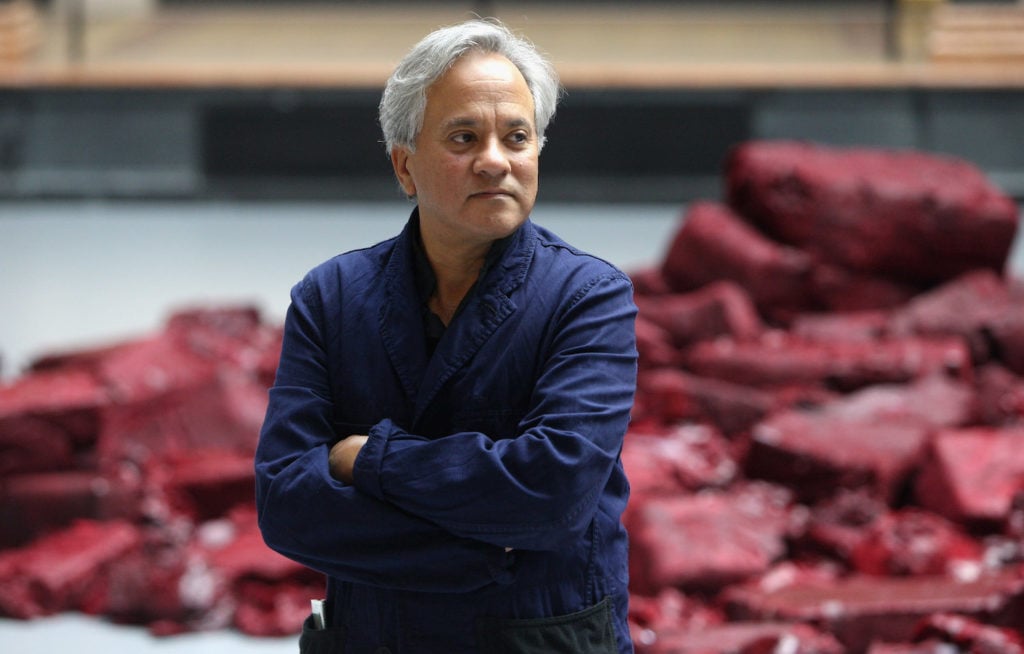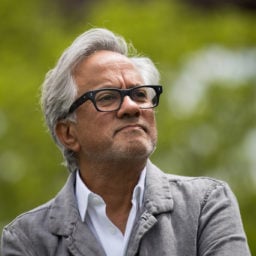Last month, a battery of ambitious and intimately related art shows opened on opposite ends of the planet. One is a historic exhibition across both Beijing’s Central Academy of Fine Arts and a venerated Ming dynasty temple outside the Forbidden City. The others are a pair of shows at Lisson Gallery in New York. What unites all these events is that they feature the art of Anish Kapoor, one of the most globally admired artists in the world, whose precisely engineered, perception-defying art is often epically scaled and has been displayed everywhere from the Venice Biennale, where he represented Great Britain in 1990, to the palace at Versailles.
But while Kapoor is renowned as an artist, he is also well known for his strong political stances, which have led him to stand up against governments in Britain, India, and China in the defense of the rights of migrants, dissidents, and the otherwise-disenfranchised. Earlier this year, he even took on the feared National Rifle Association—and more remarkably, he won, forcing it to remove one of his artworks from an advertising campaign.
Recently, Artnet News editor-in-chief Andrew Goldstein sat down with Kapoor at Lisson to talk about the ethical conundrum of showing in China, his feud with the artist Stuart Semple on who has the blackest paint, and why he tries to “avoid meaning” in his work.
Click here to listen to an audio version of this interview on our Art Angle podcast.
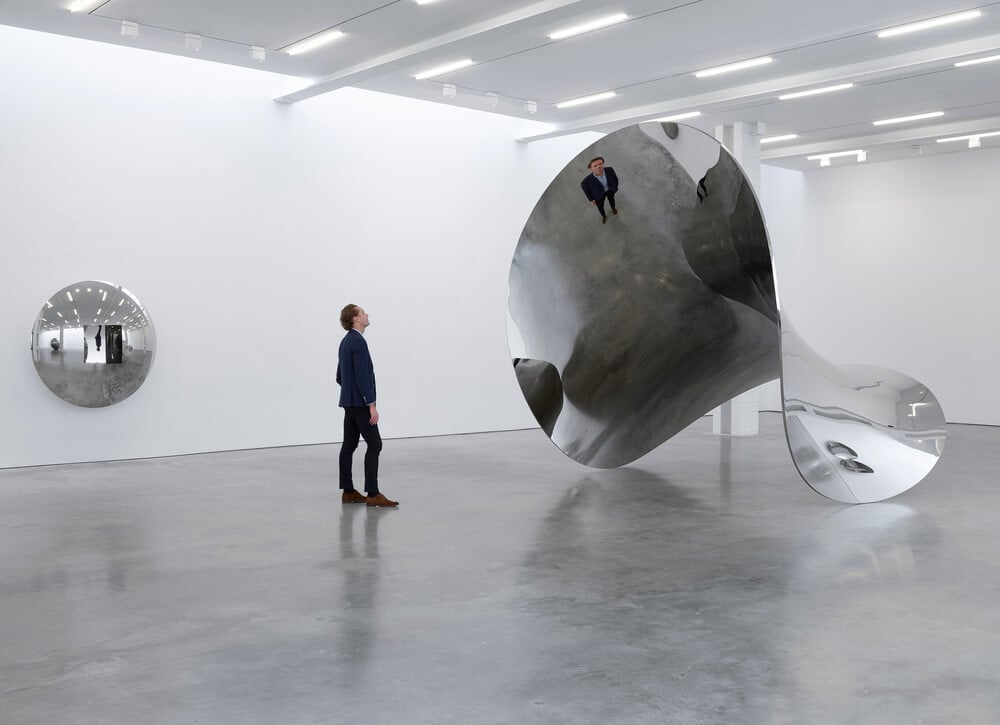
Installation view of “Anish Kapoor” at Lisson Gallery, New York. Courtesy of Lisson.
So I just had the pleasure of going through your show. It is filled with these spectacular reflective objects that are precisely created and incredibly gripping to look at, and the center of the gallery is dominated by this massive sculpture that I can only describe as a giant, mirrored Pringle. Can you tell me about this show and what you were aiming to achieve with this, and what were the problems that you are proudest of overcoming?
The show, I think, is a series of propositions that are objects perhaps in transition, that are objects that are both very physical and present and completely illustory. Many of them have interiors that belie the thing that contains them. So it’s something I’ve come to over years of work, this sense that what we know as the real world isn’t so real. That objects are often not described by their physical or apparent physical realities. So, void objects, negative spaces, involuted, upside-down, inside out: those are things that seem to occur and reoccur for me.
One thing that’s remarkable about your works is that, because they are so precise and because they are so flawlessly executed, even though they’re mirrored, the sense is that you can disappear into them. There is that experience of falling into an artwork, of losing sense of your surroundings and being immersed by it.
The traditional space of painting is always from the picture plane, deep beyond the wall behind the picture. What concavity does is to take this space and put it in front of the object. Which means that it automatically has vertigo. There is that point where light crosses over, things are reflected upside down, and then you cross over that point and they’re the right way up. And you kind of viscerally fall into them. I’m deeply interested in that as a notion.
But of course, all these really precise objects are only one side of my practice. The other side of my practice is messy, made of wax, cannons shooting, and all sorts of other things that are physical in other ways.
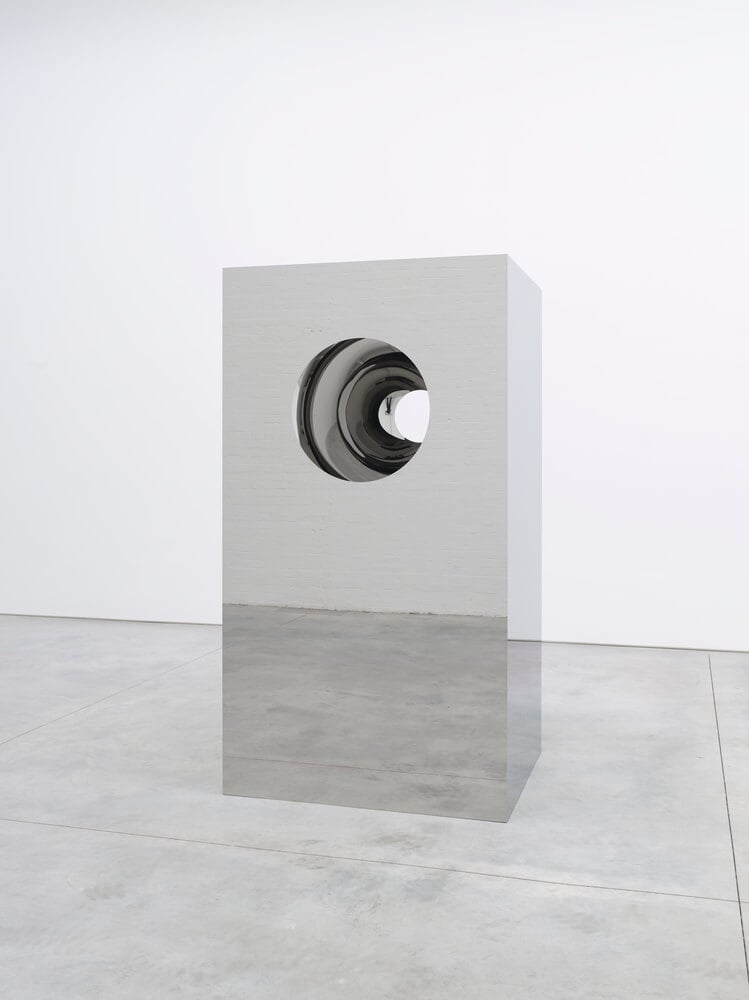
Installation view of “Anish Kapoor” at Lisson Gallery, New York. Courtesy of Lisson.
At Artnet’s 30th-anniversary dinner party, you gave a speech that really resonated with me. You were saying how, in this world of high-priced auctions and art fairs and this global art market, it’s vital for an artist to remain radical. And I wonder: What is it that you mean when you say “radical”?
Very, very hard problem, isn’t it, what’s radical today? It seems that radicality, if that really is a subject, can only come out of a truly formal discourse—and I choose my words carefully—a formal discourse with the nature of art-making. It isn’t because, if you like, it’s spinning off into politics. It seems to me that those are perfectly important questions, but questions aside from our main poetic ambition, which is to change the nature of art, not just to say something new. And I’ve always felt that, in the end, I have nothing to say as an artist. I don’t really have some message for the world.
I have a practice—a deep, real, actual, daily practice—and it’s out of that practice that content, meaning, and questions of real and unreal, et cetera, arise. But it’s only out of a practice. So I do whatever I can to avoid meaning. What I’m trying to get at is the sense that meaning arises because it must, not because I put it there.
You mentioned politics. When I think of your gigantic audiences, millions of people came through Tate Modern’s Turbine Hall to see your Unilever commission. Your audience is global and massive, both in person and on social media. You deliver art to these people, but you also are very visible as a political pundit, of sorts, as an outspoken champion of moral and urgent causes. How do you find your work and your politics intermingling? How does one help the other, and how do they fuse together? Or are they separate?
Well, years ago I kind of tumbled into the idea that it’s possible to have a voice, politically I mean. But I’ve always been rather clear with myself: I’m not interested in making agitprop.
So there are two different things that happen. One is, this is what I am as an artist. I have nothing to say as an artist. I let the work do its thing. The other is, of course I have a voice, and I will use it as best I can, and fight for causes as a citizen and as a human being, alongside compatriots of all kinds. I’ll use my voice as best I can. I feel they’re important but they’re different from each other.
You say you haven’t made agitprop, but I can think of one work that you’ve made in response to a question from Artnet News after Boris Johnson was elected Prime Minister. And you sent us a delightfully ribald cartoon. Tell me about that artwork, and tell me about your feelings about Boris Johnson and Brexit.
Well, the artwork was an image of a man with his, so to speak, bits in a twist, and I titled it, Oh to be in England now my Johnson’s in a twist. Anyway, I’ve lived in Britain for 40-odd years, and it’s been good to me. It’s a country and a people with a kind of sedate, I think, basic goodness. But something has happened. It’s as if Britain’s at war with itself. Psychically and otherwise, it seems to be grappling with the demon of nationalism, of xenophobia, of a will to see itself seemingly back in some colonial fantasy.
It really is a disease of nationalism that seems to have emerged all over the world. I mean, you have your version of it here in the US. And [Narendra] Modi in India, the madman [Jair Bolsonaro] in Brazil, and you name it in so many parts of the world. What have we done to ourselves? Terrifying. Difficult. But we somehow have to at least realize that there are ways forward. Culture, we hope, is one of the things that aspires, at least, to the better parts of ourselves.
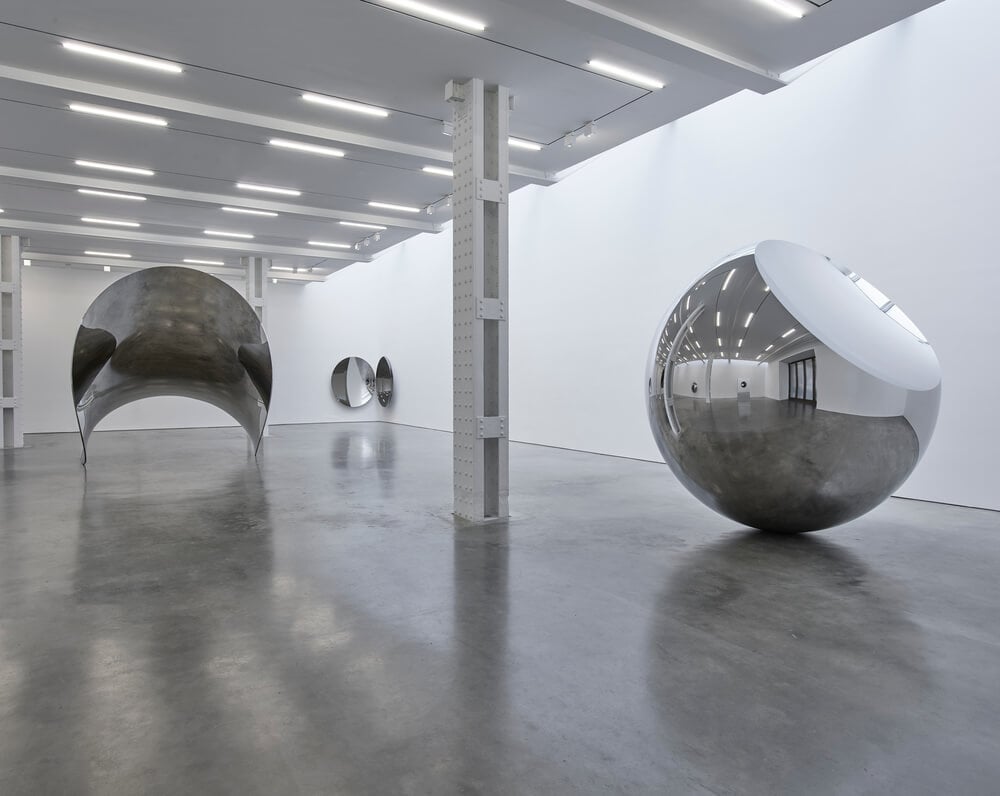
Installation view of “Anish Kapoor” at Lisson Gallery, New York. Courtesy of Lisson.
So while the democracies of the West are on fire everywhere right now, more authoritarian governments are also finding their power challenged in unprecedented ways, and you see this happening in China right now with the protests in Hong Kong. You just opened a show in Beijing, the capital of China. What does it feel like as an artist to show in China, and what do you hope to accomplish with the show?
Difficult, difficult, I have to say. Given where I stand politically, it feels like… I know I’m putting more than my toe in difficult waters here. So what does one say? Politically, I can’t agree with what’s going on in China. However, there is a real community of artists. There is real aesthetic inquiry. And it feels okay at least at some level to engage. Would it be better not to engage? I’ve asked myself this question quite seriously, and in the end I’ve obviously come out on the side of engagement.
It’s not just artists that have to deal with these questions. It’s also the NBA, Disney, every global business that wants to have a foot in China has to have a reckoning with these challenges. In the past, you’ve had a somewhat bumpy relationship with China due to your work with Ai Weiwei, who is your gallery-mate at Lisson and with whom you have championed socially progressive causes on several occasions. Has he told you how he feels about your historic show in Beijing?
It’s strange, Weiwei and I have not discussed this subject. He has, I think, taken himself out of the Chinese context in the last many years. That’s hard for him. And he’s been vocal about what’s going on in Hong Kong, and he should be. It’s a bit like doing a show in Saudi Arabia or somewhere, where one has to negotiate very, very carefully and make a balance, take a view of whether there’s greater good to be done, or whether it’s better just to keep away. In the past I have kept away. I have turned down more than one show in China, especially when Weiwei was under house arrest and I was very actively supporting his release. Do I sense that it’s changed a little bit? I hope that it’s changed a little bit.
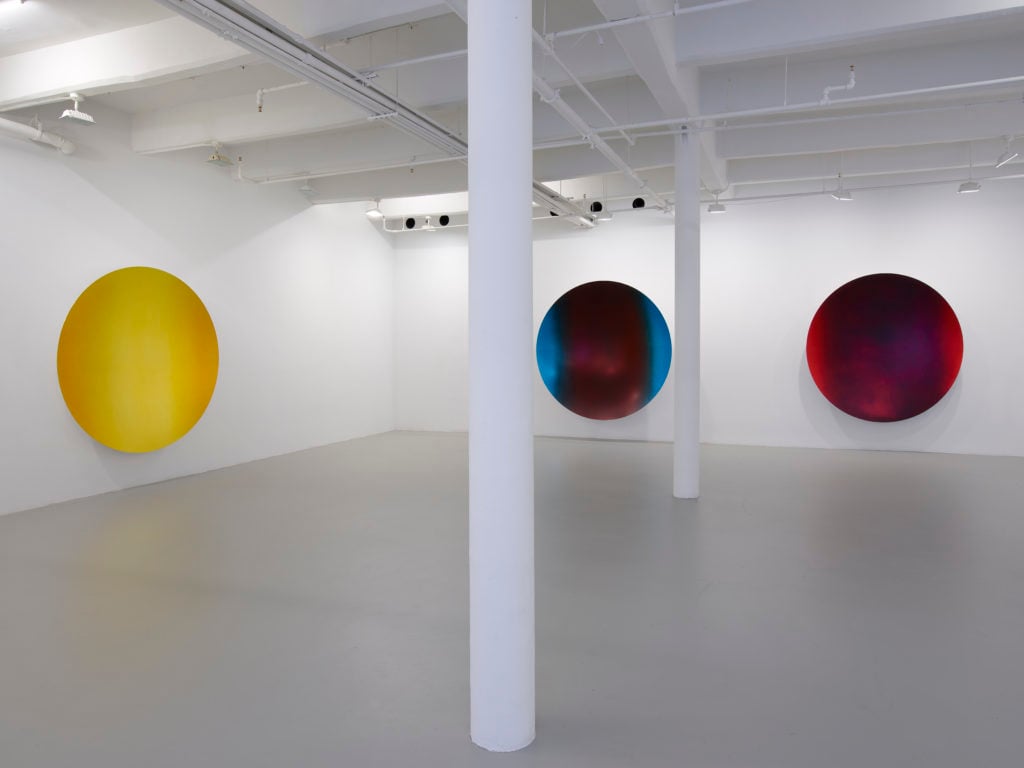
Installation view of “Anish Kapoor” at Lisson Gallery, New York. Courtesy of Lisson.
On a lighter note, I want to ask you about another battle royale that has been delighting audiences on both sides of the Atlantic. So… what is Vantablack?
I read a little piece in the newspaper four, five years ago, which said this fellow had discovered the blackest material in the universe. I wrote him a note, and I said, “Blackest material in the universe? I’m an artist. I want to use it, and I’ve been engaged with the void object forever. Can we work together?” And he wrote me back to say, “Oh god, no, it has no visual application.” I said—his name’s Ben—“Ben, c’mon Ben, let’s work at this.” He’s a very personable, good man. And so we met and had a chat, and we began to look at the possibility. He then said, “This material, of course, is made for the defense industry. It’s [top secret],” So we got permission from the Ministry of Defense to use it aesthetically. Which is, I think, a major achievement just there. And at the time they were able to make little bits, maybe two or three inches in diameter.
Now let me explain the material. It’s a nano-material that’s put onto a surface. It’s then put in what’s called a reactor. The reactor causes the particles to stand upright. And what happens of course is that as the light enters, it gets trapped in these standing fingers, these tall trees, and it can’t emerge. So this material absorbs 99.8 percent of all light. And it means that it turns light into heat. And so the object is ever so slightly warmer than its surroundings.
What we’ve done over the last [few] years is to try and understand how we can enlarge the scale to make more complex objects. So let me tell you what I’m after. I’ve said I’m engaged in this question of the dual nature of objecthood. Real/unreal, physical/not physical, void/actual, etc. Malevich’s proposition—Kazimir Malevich, the great artist who painted the Black Square—his proposition was that objects are four-dimensional—objects meaning, of course, his Black Square. Four-dimensional, that is to say, three dimensions we can observe, and then one that’s spiritual.
On the other side, in the Renaissance, there were two great ideas. One is of course perspective, which we all know about. And the other, equally important and equally interesting, is the fold. So many Renaissance painters—Mantegna or whoever you like—would use the fold, the fold in the piece of cloth. You know Renaissance paintings have these beautiful folds. The fold is a sign of being. It’s where the human being stands. So they stand in the picture, foreground or background, and then there’s perspective, then there’s deep space.
The interesting thing about this material, this black, is that when you put it on a piece of cloth, and you make a fold, the fold is invisible. You cannot see the fold. So I say this material is therefore beyond being. So I don’t make any small claim for it. It is a vast claim. It is truly four-dimensional. It is truly beyond being. And of course I’m Indian, so I love that kind of thing.
And that’s the real aim. So not dissimilar to this show out here [at Lisson in New York], which is mirrored objects that are proposing ambiguity in space, visually and otherwise. Weight and no weight, mass and no mass, illusion and reality—this black stuff does the same thing.
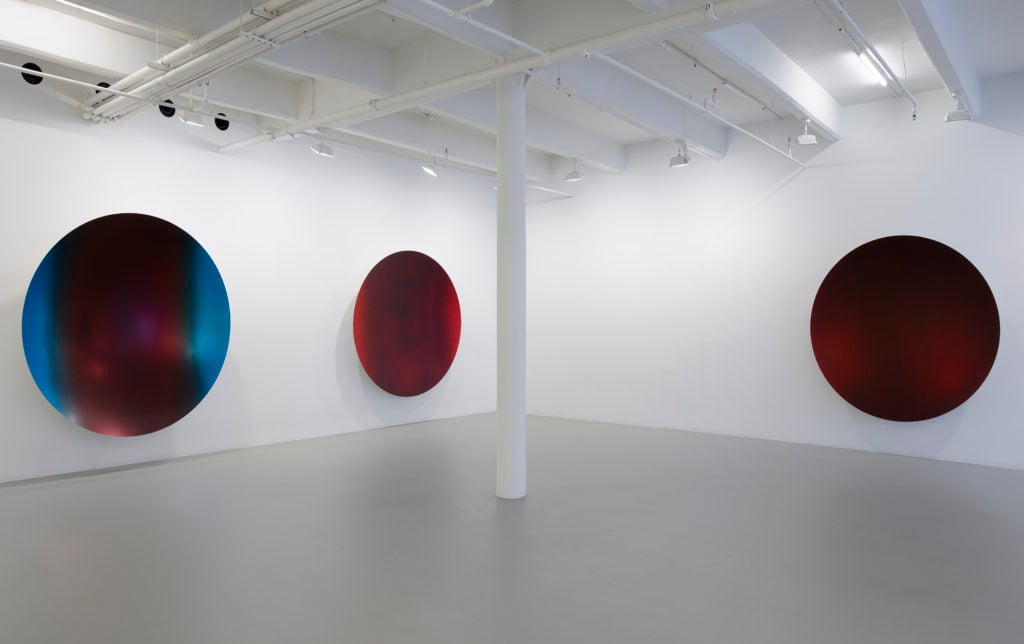
Installation view of “Anish Kapoor” at Lisson Gallery, New York. Courtesy of Lisson.
So, it’s a near-magical substance, and some artists say, “Anish, share the Vantablack with us!” But you have been keeping it proprietary.
It’s a misunderstanding. I work with a guy who makes stainless steel stuff, and we’ve worked together for years, and you know, he works for me. He doesn’t work with some other artist. He works for me.
This is similar. It’s not a black paint that comes out of a tube that I’ve patented or whatever else. It’s a highly technical, complicated, bloody ridiculously expensive process that we’ve been working our way towards trying to understand. What is a work? How do you make one? How do you make an object with this stuff?
Now there’s an arms race among people to create their version of Vantablack, and Stuart Semple is this artist who seems to have a little bit of a bone to pick with you, and who first created something he called “the pinkest pink” that was allowed to everybody in the world except to Anish Kapoor. And then you very humorously obtained some of it, and you dipped your middle finger in it, and you posted a picture, which I’m sure delighted Stuart Semple to no end.
[Laughing] I’m sure it did!
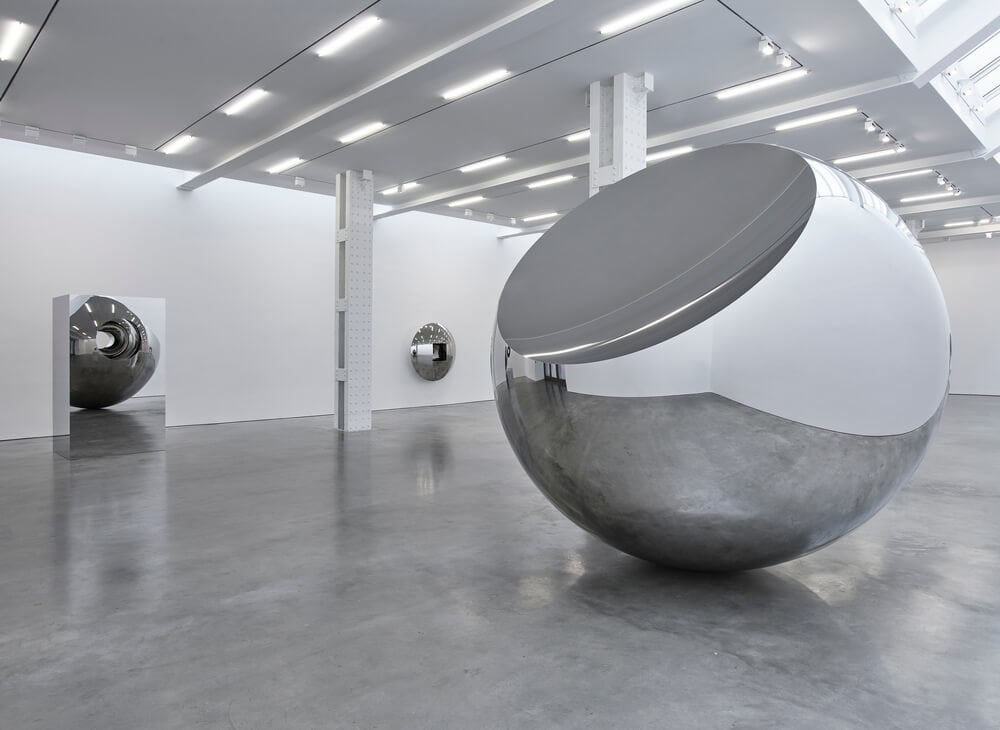
Installation view of “Anish Kapoor” at Lisson Gallery, New York. Courtesy of Lisson.
And now he has a Black 3.0, which he says rivals Vantablack, and he’s displaying it in a store in London where there is a security guard who patrols the door with a picture of you, and who is instructed not to let you go in. And every buyer has to sign a piece of paperwork to say that they won’t share it with you. So I wonder: How are you going to overcome these ironclad defenses?
Good luck to him! I’ve got nothing else to say on the subject. I’ve never engaged with it. I don’t feel it’s worth engaging with. But I mean, good luck to him.
Now there’s another artist who’s collaborating with MIT who created a black paint that has apparently made a diamond disappear. Does that excite your competitive spirit?
Oh good, it’s fine! I mean, this is technology. Of course, art and technology, at least at these levels, are quite closely linked with each other, and historically have always been. The development of oil paint brought forward a whole other way to paint, to think about what an artist could do, and so on and so forth. Likewise, good, good. Let’s hope this moves the conversation forward.
It’s not about possessing the stuff. I think the thing to remember here is that what we do as artists is mythological. We don’t make objects. We make mythological propositions. And I think part of the mythological proposition here is that this is the blackest material in the universe. Is it true? Is it not true? Who gives a shit, to be honest? The point is that it carries a sense of fiction. And what we know of course is that fiction is often more real than what’s real.
In a way, that’s what I’ve been talking about since the beginning of our conversation: objects that are and are not, fictions that are real and [unreal], fictions that are realities, etc. So Vantablack, or “the blackest black,” or AK [Anish Kapoor] Black, if you like, is a kind of fiction too.
